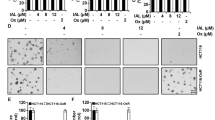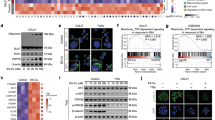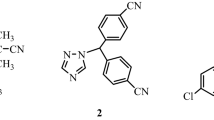Abstract
Phenethyl isothiocyanate and allyl isothiocyanate induce apoptosis of human leukaemia HL60 cells in vitro. Apoptosis was associated with cleavage of p22 BID protein to p15, p13 and p11 fragments and activation of JNK and tyrosine phosphorylation (18 kDa and 45 kDa proteins). All these effects and apoptosis were prevented by exogenous glutathione (15 mM). Protein tyrosine phosphatase activity was unchanged. The general caspase inhibitor Z-VAD-fmk prevented apoptosis but not JNK activation – excluding a role for caspases in JNK activation, whereas curcumin prevented JNK activation but only delayed apoptosis. This suggests that in isothiocyanate-induced apoptosis, the caspase pathway has an essential role, the JNK pathway a supporting role, and inhibition of protein tyrosine phosphatases is not involved. © 2001 Cancer Research Campaign
Similar content being viewed by others
Article PDF
Change history
16 November 2011
This paper was modified 12 months after initial publication to switch to Creative Commons licence terms, as noted at publication
References
Adesida A, Edwards LG and Thornalley PJ (1996) Inhibition of human leukaemia 60 cell growth by mercapturic acid metabolites of phenethyl isothiocyanate. Food Chem Toxicol 34: 385–392
Allen RE, Lo TWC and Thornalley PJ (1993) A simplified method for the purification of human red blood cell glyoxalase I. Characteristics, immunoblotting and inhibitor studies. J Prot Chem 12: 111–119
Bogaards JJP, Ommen B, Falke HE, Willems MI and Van Bladeren PJ (1990) Glutathione S-transferase subunit induction patterns of brussel sprouts, allyl isothiocyanate and goitrin in rat liver and small intestinal mucosa. Food Chem Toxicol 28: 81–88
Bossy-Wetzel E and Green DR (1999) Caspases induce cytochrome c release from mitochondria by activating cytosolic factors. J Biol Chem 274: 17484–17490
Cardone MH, Salvesen GS, Widmann C, Johnson G and Frisch SM (1997) The regulation of anoikis: MEKK-1 activation requires cleavage by caspases. Cell 90: 315–323
Chen Y-R and Tan T-H (1998) Inhibition of the c-Jun N-terminal kinase (JNK) signaling pathway by curcumin. Oncogene 17: 178
Chen Y-R, Wang W, Kong T and Tan T-H (1998) Molecular mechanism of c-Jun N-terminal kinase-mediated apoptosis induced by anticarcinogenic isothiocyanates. J Biol Chem 273: 1769–1775
Chen Y-R, Wang X, Templeton D, Davies RJ and Tan T-H (1999) The role of c-Jun N-terminal kinase (JNK) in apoptosis induced by ultraviolet C and γ radiation. J Biol Chem 271: 31929–31936
Conaway CC, Jiao D and Chung F-L (1996) Inhibition of rat liver cytochrome P450 isozymes by isothiocyanates and their conjugates: A structure-activity relationship study. Carcinogenesis 16: 2423–2427
Denu JM and Tanner KG (1998) Specific and reversible inactivation of protein tyrosine phosphatases by hydrogen peroxide: evidence for a sulfenic acid intermediate and implications for redox regulation. Biochemistry 37: 5633–5642
Faris M, Kokot N, Latinis K, Kasibhatla S, Green DR, Koretzky GA and Nel A (1998) The c-jun N-terminal kinase cascade plays a role in stress-induced apoptosis in Jurkat cells by up-regulating fas ligand expression. J Immunol 160: 134–144
Gross A, Yin X-M, Wang K, Wei MC, Jockel J, Milliman C, Erdjument-Bromage H, Temps P and Korsmeyer SJ (1999) Caspase cleaved BID targets mitochondria and is required for cytochrome c release, while BCL-XLprevents this release but not tumour necrosis factor-R1/Fas death. J Biol Chem 274: 1156–1163
Hecht SS (1995) Chemoprevention by isothiocyanates. J Cell Biochem 22: 195–209
Kharbanda S, Saxema S, Yoshida K, Pandey P, Kaneki M, Wang QZ, Cheng K, Chen YN, Campbell A, Sudha T, Yuan ZM, Narula J, Weichselbaum R and Kufe D (2000) Translocation of SAPK/JNK to mitochondria and interaction with Bcl-xLin response to DNA damage. J Biol Chem 275: 322–327
Komada Y, Inaba H, Zhou Y-W, Zhang X-L, Tanaka S, Azuma E and Sakurai M (1997) mRNA expression of fas receptor (CD95)-associated proteins (Fas-associated phosphatase-1/FAP-1, fas-associating protein death domain/FADD, and receptor-interacting proteins/RIP) in human leukaemia/lymphoma cell lines. Brit J Haematol 99: 325–330
Li H, Zhu H, Xu C-J and Yuan J (1998) Cleavage of BID by caspase 8 mediates the mitochondrial damage in the Fas pathway of apoptosis. Cell 94: 491–501
Li Y, Kanki H, Hachiya T, Ohyama T, Irie S, Tang G, Mukai J and Sato TA (2000) Negative regulation of fas-mediated apoptosis by FAP-1 in human cancer cells. Internat J Cancer 87: 473–479
Lumelsky NL and Schwartz BS (1996) Protease inhibitors induce specific changes in protein tyrosine phosphorylation that correlate with inhibition of apoptosis in myeloid cells. Cancer Res 56: 3909–3914
Nishikawa A, Lee I-S, Uneyama C, Furukawa F, Kim H-C, Kasahara K, Huh N and Takahashi M (1997) Mechanistic insights into chemopreventive effects of phenethyl isothiocyanate in N-nitrosobis(2-oxopropyl)amine-treated hamsters. Jpn J Cancer Res 88: 1137–1142
Samaha HS, Kelloff GJ, Steele V, Rao CV and Reddy BS (1997) Modulation of apoptosis by sulindac, curcumin, phenylethyl-3-methylcaffeate and 6-phenylhexyl isothiocyanate: apoptotic index as a biomarker in colon cancer chemoprevention and promotion. Cancer Res 57: 1301–1305
Sugie S, Yoshimi N, Okumara A, Tanaka T and Mori H (1999) Modifying effects of benzyl isothiocyanate and benzyl isocyanate on DNA synthesis in primary culture of rat hepatocytes. Carcinogenesis 14: 281–283
Xu K and Thornalley PJ (2000) Studies on the mechanism of the inhibition of human leukaemia cell growth by dietary isothiocyanates and their cysteine adducts. in vitro. Biochem Pharmacol 60: 221–231
Xu K and Thornalley PJ (2001) Involvement of GSH metabolism in the cytotoxicity of the phenethyl isothiocyanate and its cysteine conjugate to human leukaemia cells. in vitro. Biochem. Pharmacol 61: 165–177
Yu R, Jiao J-J, Duh J-L, Tan T-H and Kong A-NT (1996) Phenethyl isothiocyanate, a natural chemopreventive agent, activates c-Jun N-terminal kinase-1. Cancer Research 56: 2954–2959
Zheng G, Kenney PM and Lam LKT (1992) Phenylalkyl isothiocyanates-cysteine conjugates as glutathione S -transferase stimulating agents. J Med Chem 35: 185–188
Author information
Authors and Affiliations
Rights and permissions
From twelve months after its original publication, this work is licensed under the Creative Commons Attribution-NonCommercial-Share Alike 3.0 Unported License. To view a copy of this license, visit http://creativecommons.org/licenses/by-nc-sa/3.0/
About this article
Cite this article
Xu, K., Thornalley, P. Signal transduction activated by the cancer chemopreventive isothiocyanates: cleavage of BID protein, tyrosine phosphorylation and activation of JNK. Br J Cancer 84, 670–673 (2001). https://doi.org/10.1054/bjoc.2000.1636
Received:
Revised:
Accepted:
Published:
Issue date:
DOI: https://doi.org/10.1054/bjoc.2000.1636
Keywords
This article is cited by
-
Benzyl isothiocyanate induces protective autophagy in human lung cancer cells through an endoplasmic reticulum stress-mediated mechanism
Acta Pharmacologica Sinica (2017)
-
Isothiocyanates: a class of bioactive metabolites with chemopreventive potential
Tumor Biology (2015)
-
Mitochondrial translocation of cofilin is required for allyl isothiocyanate-mediated cell death via ROCK1/PTEN/PI3K signaling pathway
Cell Communication and Signaling (2013)
-
Isothiocyanates induce oxidative stress and suppress the metastasis potential of human non-small cell lung cancer cells
BMC Cancer (2010)
-
Are isothiocyanates potential anti-cancer drugs?
Acta Pharmacologica Sinica (2009)



